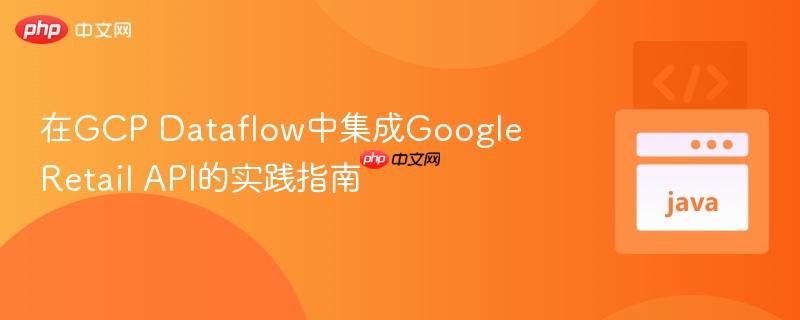
gcp dataflow目前没有为google retail api提供像bigqueryio那样的专用io类。本文将指导您如何在dataflow管道的`dofn`中自定义调用retail api,并重点强调了api配额管理、认证以及客户端库集成等关键实践,以确保高效稳定地进行数据交互。
Google Cloud Dataflow(基于Apache Beam)为许多Google Cloud服务提供了便捷的IO连接器,例如用于BigQuery的BigQueryIO。然而,对于Google Retail API,目前并没有直接可用的专用IO类。这意味着,当需要在Dataflow管道中与Retail API进行交互(例如,写入用户事件、获取产品信息或进行预测)时,开发者需要采用自定义的方式来实现。核心思路是在Dataflow的DoFn(分布式函数)中直接调用Retail API的客户端库。
在Dataflow中调用Google Retail API的关键在于利用DoFn的生命周期方法(setup、process、teardown)来管理API客户端和执行API请求。
首先,确保您的Dataflow作业能够访问Google Retail API的客户端库。对于Python,这意味着在您的项目依赖中添加google-cloud-retail。这通常通过setup.py文件或在运行Dataflow作业时使用--requirements_file参数来指定。
# setup.py 或 requirements.txt 中 google-cloud-retail google-cloud-retail-v2 # 推荐使用v2版本 apache-beam[gcp]
为了避免在每个数据元素处理时重复创建客户端实例,应在DoFn的setup方法中初始化API客户端。setup方法在DoFn的每个工作器实例启动时执行一次。
import apache_beam as beam
from apache_beam import DoFn
from google.cloud import retail_v2
from google.protobuf import timestamp_pb2
import datetime
class WriteRetailUserEventFn(DoFn):
def __init__(self, project_id: str, location: str = "global", catalog_id: str = "default_catalog"):
"""
初始化DoFn,传入项目ID、位置和目录ID。
这些参数在DoFn实例化时传递,而非在setup中。
"""
self.project_id = project_id
self.location = location
self.catalog_id = catalog_id
self.user_event_client = None
self.parent_path = None
def setup(self):
"""
在每个工作器实例启动时初始化Retail API客户端。
Dataflow的Service Account将隐式处理认证。
"""
self.user_event_client = retail_v2.UserEventServiceClient()
self.parent_path = f"projects/{self.project_id}/locations/{self.location}/catalogs/{self.catalog_id}"process方法是DoFn的核心,它会为PCollection中的每个元素执行。在这里,您将从输入元素中提取所需数据,构建Retail API请求,并执行API调用。
def process(self, element: dict):
"""
处理PCollection中的每个元素,将其转换为Retail用户事件并写入API。
'element' 预期是一个字典,包含用户事件数据。
"""
try:
# 构造UserEvent对象
user_event = retail_v2.UserEvent(
event_type=element.get("event_type"),
visitor_id=element.get("visitor_id"),
event_time=self._to_timestamp_proto(element.get("event_time")), # 转换时间戳格式
product_details=[
retail_v2.ProductDetail(product=f"projects/{self.project_id}/locations/{self.location}/catalogs/{self.catalog_id}/products/{pid}")
for pid in element.get("product_ids", [])
],
uri=element.get("uri"),
referrer_uri=element.get("referrer_uri"),
page_view_id=element.get("page_view_id"),
# 根据您的数据模式和Retail API要求添加其他相关字段
)
# 调用Retail API写入用户事件
response = self.user_event_client.write_user_event(parent=self.parent_path, user_event=user_event)
# Yield响应或确认消息,供下游处理/日志记录
yield f"Successfully wrote user event for visitor_id: {user_event.visitor_id}, event_type: {user_event.event_type}"
except Exception as e:
# 记录错误,并可能将失败的元素发送到死信队列
beam.metrics.Metrics.counter('retail_api_errors', 'write_event_failed').inc()
print(f"Error writing Retail user event for element {element}: {e}")
# 考虑yield一个错误对象或使用侧输出(Side Output)进行错误处理
# 示例: yield beam.pvalue.TaggedOutput('errors', {'element': element, 'error': str(e)})
def _to_timestamp_proto(self, dt_obj):
"""
辅助方法:将datetime对象或ISO格式字符串转换为protobuf Timestamp。
"""
if dt_obj is None:
return None
if isinstance(dt_obj, datetime.datetime):
timestamp = timestamp_pb2.Timestamp()
timestamp.FromDatetime(dt_obj)
return timestamp
elif isinstance(dt_obj, str):
try:
# 假设是ISO格式字符串,如 "2023-10-27T10:00:00Z"
dt_obj = datetime.datetime.fromisoformat(dt_obj.replace('Z', '+00:00'))
timestamp = timestamp_pb2.Timestamp()
timestamp.FromDatetime(dt_obj)
return timestamp
except ValueError:
# 如果无法解析,可以返回None或抛出错误
return None
return None在Beam管道中使用示例:
# 假设您已经定义了WriteRetailUserEventFn类
# with beam.Pipeline() as pipeline:
# user_events_data = [
# {"event_type": "page-view", "visitor_id": "user1", "event_time": datetime.datetime.now(), "uri": "/product/A"},
# {"event_type": "add-to-cart", "visitor_id": "user2", "event_time": "2023-10-27T10:30:00Z", "product_ids": ["P123"]},
# ]
# results = (
# pipeline
# | 'CreateUserEvents' >> beam.Create(user_events_data)
# | 'WriteToRetailAPI' >> beam.ParDo(WriteRetailUserEventFn(project_id="your-gcp-project-id"))
# | 'LogResults' >> beam.Map(print)
# )
# pipeline.run().wait_until_finish()请将示例代码中的"your-gcp-project-id"替换为您的实际项目ID。
在Dataflow中自定义调用Retail API时,需要考虑以下几点以确保管道的稳定性和效率:
Dataflow作业通常以高并行度运行,这可能导致对Retail API产生大量并发请求。过度使用API配额可能导致请求被限流或拒绝。
Dataflow作业通常使用其关联的服务账号进行认证。
API调用可能因网络问题、配额限制、无效请求或后端服务问题而失败。
确保Dataflow作业能够正确加载google-cloud-retail及其所有依赖项。
如果API客户端有明确的关闭或清理方法,可以在DoFn的teardown方法中执行,以释放资源。
尽管GCP Dataflow没有为Google Retail API提供现成的IO连接器,但通过在自定义DoFn中集成Retail API客户端库,开发者可以灵活地在Dataflow管道中实现与Retail API的交互。成功的
以上就是在GCP Dataflow中集成Google Retail API的实践指南的详细内容,更多请关注php中文网其它相关文章!

每个人都需要一台速度更快、更稳定的 PC。随着时间的推移,垃圾文件、旧注册表数据和不必要的后台进程会占用资源并降低性能。幸运的是,许多工具可以让 Windows 保持平稳运行。

Copyright 2014-2025 https://www.php.cn/ All Rights Reserved | php.cn | 湘ICP备2023035733号